 Alfred Ajibola
- 07th February, 2019 @ 11:58 AM
Alfred Ajibola
- 07th February, 2019 @ 11:58 AM
Topics in Basic Technology
Definitions of technology and their explanations Examples of technology Forms of technology explained with their differences Types of chain drive Types of belt drive Types of Ceramics Advantages and Disadvantages of Chain Drives Len Academy Questions for Basic Technology JSS3, 2nd Term Len Academy Basic Technology Questions, JSS3 Belt and Pulley Drives: Types of belt in belt drives Refrigerator as an electromechanical device, its parts and operations What is chain drive? Classification of chain drive What are Belt Drives? Advantages and Disadvantages of Belt Drives Type of Lines in Technical Drawings Len Academy questions for Basic Technology, JSS2, 2nd Term Len Academy questions for Basic Technology JSS2, 2nd Term, Part 2 What is Maintenance? Types of Maintenance Hardwood and Softwood - Characteristics and Examples What are Ceramics? Characteristics of CeramicsAcademic Questions in Basic Technology
The _____ functions to remove excess heat from the refrigerator.
A. Evaporator
B. Compressor
C. Condenser
D. Expansion Valve
E. Thermostat
F. Defrost System
A fluid or gas that runs through the compartments of a refrigerator is termed _____.
A. Water vapor
B. Liquid vapor
C. Frost
D. Refrigerant
E. Compressed water
F. Evaporated water
Current flows through a path called _____.
A. Electricity
B. Electric Route
C. Electrolysis
D. Transformer
E. High Tension
F. Electric Circuit
Googles are safety wears.
A. True
B. False
Which of the following is false concerning advanced ceramics?
A. They can be made from metallic oxides
B. They are very hard and durable
C. They are corrosion resistant
D. They are fired in the presence of oxygen
E. They are fired at a very high temperature of about 1700oC
F. They can be made from non-oxides such as carbides and borides
A thin continuous line is used for representing the followings except _____.
A. Intersections
B. Hatching lines
C. Long breaks
D. Diagonal line used to state plane surfaces
E. Leader lines
F. Back section lines
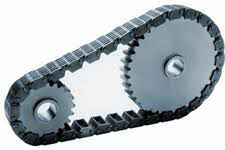
With regards to chain drives, the diagram above is a/an _____ chain.
A. Roller
B. Silent
C. Leaf
D. Flat-top
E. Detachable
F. Acceleration
A type of chain drive commonly used in bicycles is the _____ chain.
A. Roller
B. Silent
C. Leaf
D. Flat-top
E. Detachable
F. Acceleration
Wood is derived from the stem, trunks and branches of trees.
A wood is an organic material and a structural tissue composed mainly of cellulose; and it constitutes the stem, roots and branches of trees.
You can read on the trees found in tropical rainforest here.
The outermost skin or covering of the wood is called the bark. On peeling off the bark, next to be seen is the sapwood which contains the plant's transport system called the xylem. Also seen inside the sapwood is the heartwood, but here, the xylem is blocked with gums; making it functionally inactive. The cambium is seen around the edge of the sapwood. This is shown in the image below:
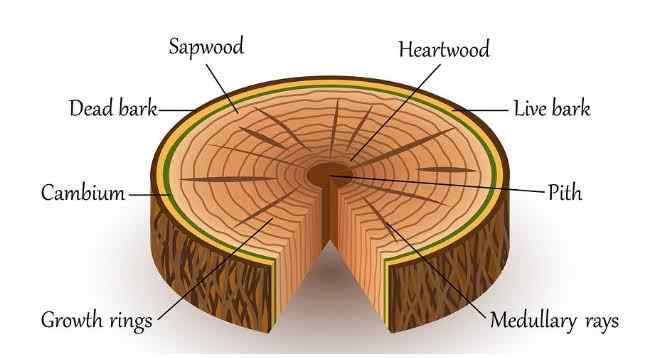
We have two types of wood. These are:
Hardwood
Softwood
Generally, woods are porous and fibrous in nature. However, the terms 'hardwood and softwood' don't always refer to the wood's actual hardness or softness.
You can read on the roles of government in agriculture here.

Hardwoods are derived from angiosperms.
Angiosperms are flowering plants that produce seeds encased in fruits or pods.
Please read on the differences between gymnosperms and angiosperms.
Most times, hardwood are stronger than softwood but there are exceptions. For instance, balsa is a hardwood that is actually soft.
Examples of hardwood include iroko, ash, beech, alder, teak, birch, mahogany, maple, oak, balsa and walnut.
You can attempt Len Academy examination questions for JSS2 basic technology here.

Softwoods are often derived from coniferous trees, that is: trees with needle-like leaves, and whose seeds are covered in cones.
Note: Coniferous trees are classified under gymnosperms.
Please read on the anatomical and structural differences between gymnosperms and angiosperms here.
You can read on the characteristics of ceramics here.
You can read on interesting facts for students here.
Examples of softwood include cedar, larch, juniper, yew, cypress, fir, pine, spruce, douglas fir and redwood.
Kindly share this article via the links below:

Please click here to contact Alfred if you require any of the following services:
If you need a standard website at an affordable price.
Online training on the academic subjects: biology, chemistry and basic science.
If you require an advanced smart school management system (web application) for your school.
Click here to read on Len Academy Smart School Software.
Please click here to follow Len Academy on Google News.
Amazing facts in Basic Technology
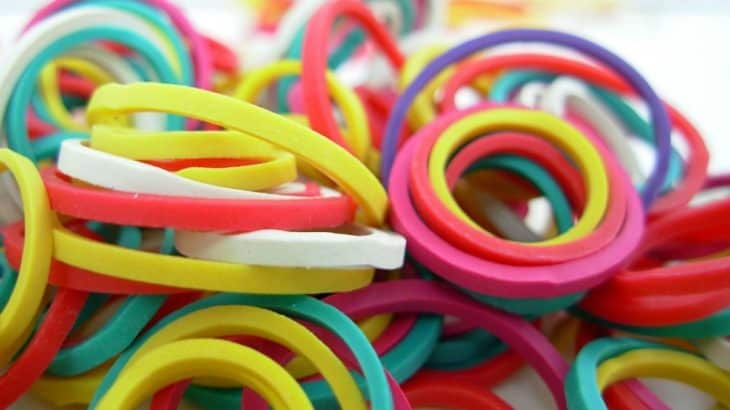
Rubber bands last longer when refrigerated
Lighter was invented before matches
Johann Wolfgang Dobereiner was credited with the invention of lighter in 1826 while the match was made 3 years later
Volkswagen group of companies own some of the top cars of the world. These are Audi, Bentley, Bugatti, Ducati, Lamborghini and Porsche
Notable points in Basic Technology
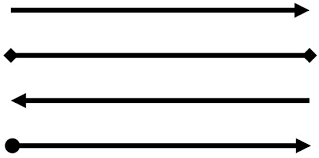
Arrowhead lines are lines with pointed edges at one or both ends. The pointed edges are in the form of an arrow.
Arrowhead lines are used:
At the end of dimensional lines.
As measurement lines.
A thin continuous line could be a straight or curved line. However, the main point to remember is this: 'it is a tiny line with no dot or dashes within it'.
_______________________
A thin continuous line is used for representing the followings:
Projection lines
Hatching lines
Construction lines
Short center lines
Measurement lines
Diagonal lines used to state plane surfaces
Intersections
Leader lines
Backside section lines
Any action that involves the servicing, checking, replacing and repairing of an equipment, object or device is termed maintenance.
Maintenance has two main goals. These are:
To prevent a breakdown
To repair the breakdown
Below are the types of maintenance:
Preventive maintenance
Corrective maintenance
Predictive maintenance
Periodic maintenance
Reinforcement
Overhaul

Softwoods are often derived from coniferous trees, that is: trees with needle-like leaves, and whose seeds are covered in cones.
Below are some characteristics of softwood:
Most softwood have lower densities than hardwood (weighs lower).
In terms of price, they are often less expensive than hardwood.
Their growth rate is faster than hardwood.
Most softwood do not shed their needle-like leaves during the year. However, the softwood 'larch' and 'cypress' are exceptions.
They are less fire resistant.
The diagram below shows the various types of line in technical drawing, their description and general application:
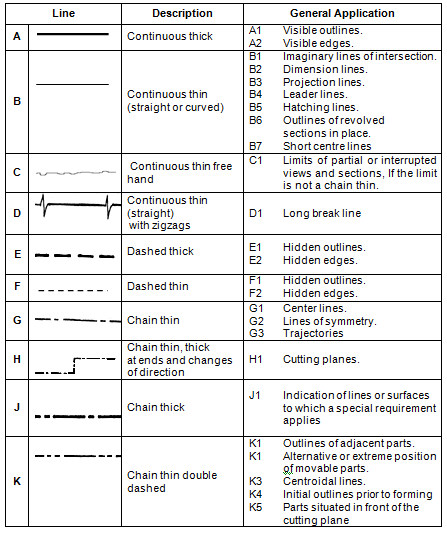
Please read more on the types of line in technical drawing here